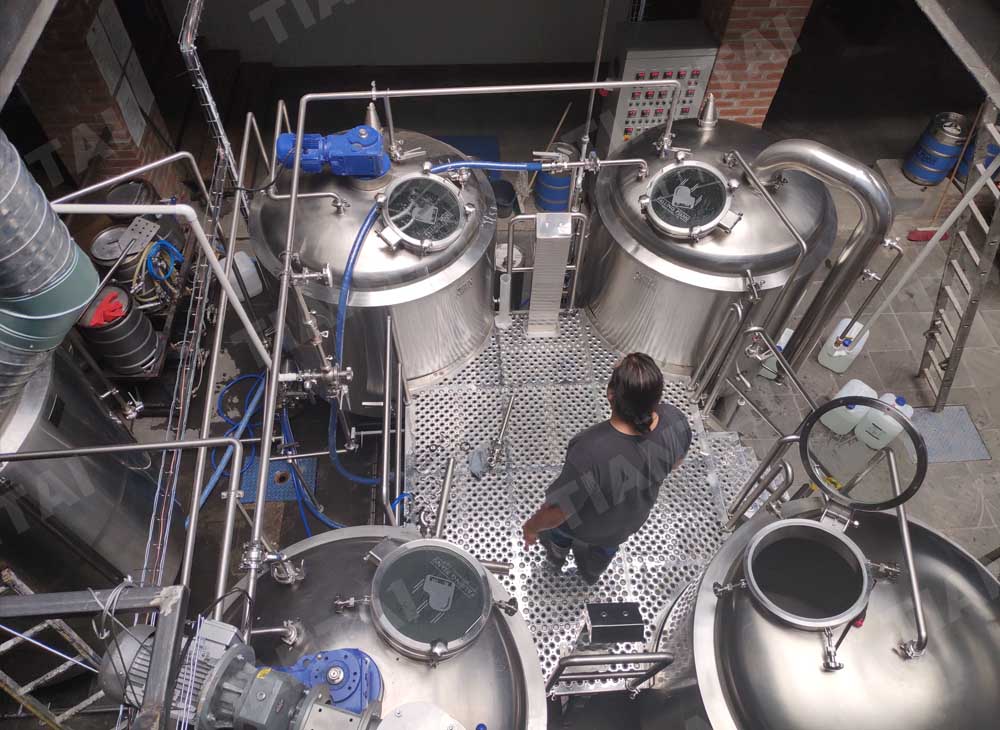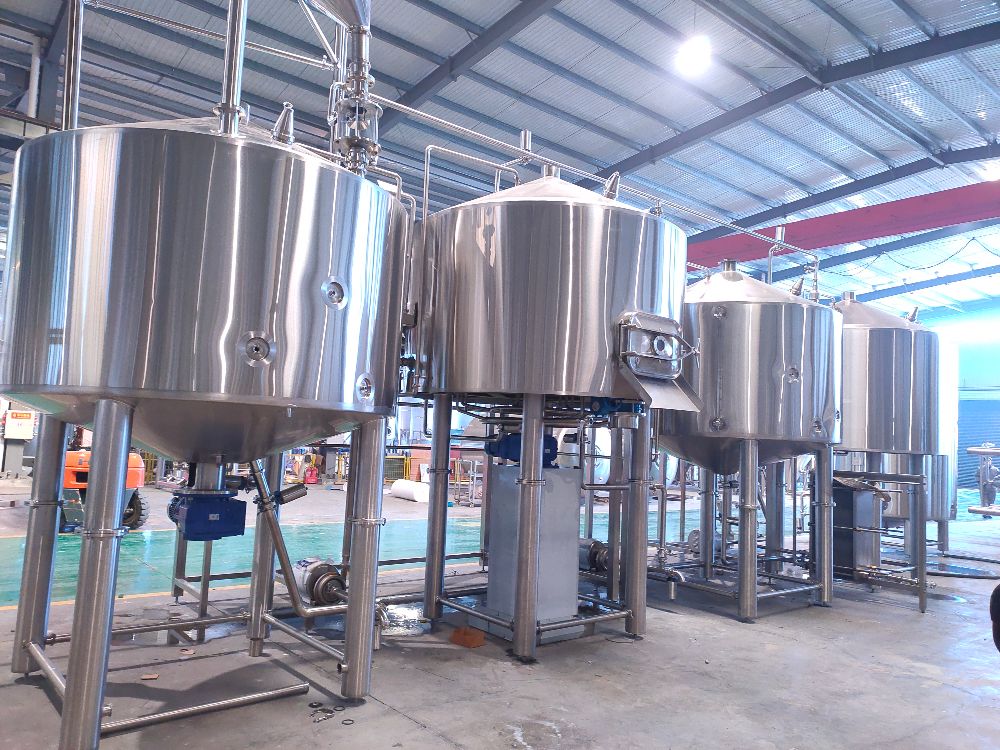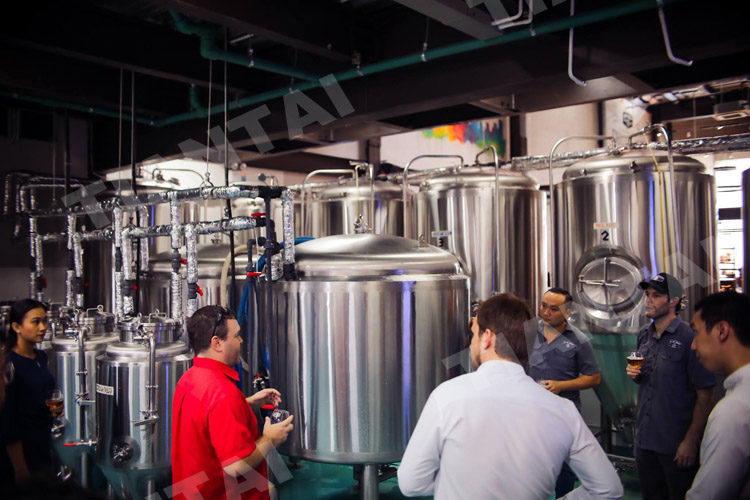BREWERY SIZING
- Feb 11, 2022
- 54
- tiantai
At Forgeworks, we mostly specialize in building 3.5, 5, 7 & 10 Barrel Brewhouses, the excellent system size range for the Brewpub company model. To sustain this size range for lengthy term development, we use up to 2x & 3x sized Fermenters as well as Brights, as well as Hot/Cold Liquor Tanks. Need to that be the instance, you may see a return on investment with these included attributes, but not till you reach that quantity of brewing, as well as if that is what you are anticipating within the initial 5-7 years, highly consider the following size up, or 2 sizes up.
At Forgeworks, our core focus is developing brewhouses that use soft hose pipe links as well as basic controls. With this idea, we take our space in the Craft Brewing Industry, for the Brewpub dimension brewery. We are recognized for our equipment to be burley as well as simple to utilize, and for our consultation with our clients in regards to making the most of the called for start up tools, versus available start-up funding. We share ideas on what equipment can conveniently be included later on, and also how you can prepare for regulated growth with the system you pick. Our internet site is loaded with details to back up as well as support our ideas and also we trust you will discover this helpful as you create your task strategies. Occasionally, a few of our clients have asked us to build their brewhouse with a rake and also rake, process piping and more complex controls to finest fit their demands, goals and projections, however we really feel such devices at this range is commonly the exemption.

It must be noted that as you analyze your contrasts with brewhouse manufacturers/suppliers, you will locate that lots of outfit their Brewpub sized systems with all the bells and whistles, process piping, and fancy controls, that you don't require. Generally the rate tag on these systems is even more than a Forgeworks brewhouse. These systems are packaged with much inferior supplementary equipment, such as pumps, heat exchangers, and also various other equipment that can be problematic to service.
For the Brew Pub business model, a 7bbl or 10bbl Brewhouse appears to be rather the pleasant spot. One really vital consideration when assessing which size Brewhouse to invest in is; will it allow you the ability to reach your forecasted yearly production goals 5 or more years down the road? Component of this examination is inclusive of a very mindful analysis of what square footage you would need, square footage that would certainly likewise permit space for added fermentation ability in the future. Will you have area to develop an excellent sized chilly room (you will desire one as large as possible)? Most Brew Pub sized breweries begin with 1-2 mixtures per week, and that might differ with the year, for the very first 3 or two years. At some time, among your selections of beers will be the dominate seller, and when you look at your production logs for the year, you discover that you have made that specific beer method greater than any others, and you seem to keep running out, most likely due to the fact that you are not able to time brews to replenish as the fermenters are inhabited with various other selections. Soon, you will be considering the enhancement of an additional fermenter, and will likely contemplate a 2x sized fermenter to accomodate a back to back brew of that prominent beer. Consider steering far from situations with a brewhouse size that have you making 3-4 or even more times a week (50 weeks annually) after 2 to 4 years.
At startup, be extremely cautious if your annual barrel manufacturing projection dictates that you would size up to a bigger brewhouse after a 2-3 years. Possibly you are thinking about a smaller sized brewhouse for your launch (based on your start-up budget), with the idea of sizing up after year 2 or 3.
3.5, 5, 7 or 10 barrels? How do you pick the best brewhouse dimension? Some good questions to begin with are:
What is your forecasted annual manufacturing in barrels for the brewery?
What is the brewery's growth plan, 3-5 years out? Will the space you are considering support development in regards to including fermentation ability to satisfy forecasted goals/demand for 5-7 years?
Will your forecasts permit your production to accommodate included sales from over-the-counter package, or local self-distribution?
As you are taking into consideration property/facility room, Forgeworks can aid you comprehend the area needed for each dimension system by offering you with a brewhouse impact. We can also create a floorplan to scale (based on the area you are either thinking about or have safeguarded) to assist you recognize how to best make use of every square foot of the brewery. Even if a specific tools item is not provided by us, if you get us the measurements we can include it in the space plan.
Various other noteworthy Considerations:
1) For a really tiny adder in rate for one or more of your fermenters, you can transform the storage tank to a Uni-Tank, which gets you a carbonation port and also a view tube for tax decision. The fermenter as a Uni-Tank comes to be a Bright and a Serving tank in one. You might not have the luxury of linking up the fermenter for a longer duration of time, it is still wonderful to have the ability to use the fermenter as a bright tank.
2) Will you have sufficient freezer for single-wall offering containers as well as kegs to fulfill your forecasted yearly manufacturing? We suggest you plan for the largest chilly space possible. An excellent amount of serving storage tanks will maintain at bay your demand for jacketed brights.
3) Related to your initial spending plan, does it consist of expenditures on equipment that can be conveniently added after a year or 2 of operating? Are these things adding up even to determine the size brewhouse that is budget friendly at launch? Are you consisting of wonderful to have versus need to have ancillary tools in your spending plan that could be foregone? Devices products that can be added later consist of: extra pump(s), VFD's on pumps, brew deck system, barley cracker (mill), an auger/conveyance for a grain mill, fancy CIP/Keg Washing station, self-heating Hot Liquor Tanks, as well as converting some connections to stainless-steel piping. Nice points that are not always required points include process piping for the brewhouse, much more complex controls, and also rake and plow on the Mash Tun. If you are forced into a choice for a certain size brewhouse because of the products defined in this paragraph, then it's worth playing around with reviewing a various launch situation that takes into consideration decreasing the tools you will certainly start with (you can include later as revenues are moving), as well as getting rid of some of the wonderful attributes that are not definitely needed (these normally have a bleak return on investment overview in regards to labor cost savings).
4) Choosing to invest in the brewhouse dimension that will certainly serve your goals as well as demands on your beer well through year 5 is commonly the most effective choice. You can begin with marginal fermentation capability and also slowly include additional tanks (probably used) as you see need unfolding. Possibly you can introduce visitor taps to raise selection, while you strategize on including fermentation capability to satisfy need.
To sustain this dimension array for lengthy term growth, we offer up to 2x & 3x sized Fermenters as well as Brights, as well as Hot/Cold Liquor Tanks. Must that be the case, you may see a return on financial investment with these added features, yet not till you reach that quantity of brewing, as well as if that is what you are anticipating within the first 5-7 years, highly take into consideration the following dimension up, or two sizes up. Take into consideration steering away from situations with a brewhouse dimension that have you making 3-4 or more times a week (50 weeks per year) after 2 to 4 years.
At start-up, be very careful if your yearly barrel production projection determines that you would size up to a larger brewhouse after a 2-3 years. Probably you are taking into consideration a smaller sized brewhouse for your launch (based on your start-up budget plan), with the concept of sizing up after year 2 or 3.
Laura hou
Sales manager
Tiantai Beer Equipment
[email protected]
At Forgeworks, our core focus is developing brewhouses that use soft hose pipe links as well as basic controls. With this idea, we take our space in the Craft Brewing Industry, for the Brewpub dimension brewery. We are recognized for our equipment to be burley as well as simple to utilize, and for our consultation with our clients in regards to making the most of the called for start up tools, versus available start-up funding. We share ideas on what equipment can conveniently be included later on, and also how you can prepare for regulated growth with the system you pick. Our internet site is loaded with details to back up as well as support our ideas and also we trust you will discover this helpful as you create your task strategies. Occasionally, a few of our clients have asked us to build their brewhouse with a rake and also rake, process piping and more complex controls to finest fit their demands, goals and projections, however we really feel such devices at this range is commonly the exemption.

It must be noted that as you analyze your contrasts with brewhouse manufacturers/suppliers, you will locate that lots of outfit their Brewpub sized systems with all the bells and whistles, process piping, and fancy controls, that you don't require. Generally the rate tag on these systems is even more than a Forgeworks brewhouse. These systems are packaged with much inferior supplementary equipment, such as pumps, heat exchangers, and also various other equipment that can be problematic to service.
For the Brew Pub business model, a 7bbl or 10bbl Brewhouse appears to be rather the pleasant spot. One really vital consideration when assessing which size Brewhouse to invest in is; will it allow you the ability to reach your forecasted yearly production goals 5 or more years down the road? Component of this examination is inclusive of a very mindful analysis of what square footage you would need, square footage that would certainly likewise permit space for added fermentation ability in the future. Will you have area to develop an excellent sized chilly room (you will desire one as large as possible)? Most Brew Pub sized breweries begin with 1-2 mixtures per week, and that might differ with the year, for the very first 3 or two years. At some time, among your selections of beers will be the dominate seller, and when you look at your production logs for the year, you discover that you have made that specific beer method greater than any others, and you seem to keep running out, most likely due to the fact that you are not able to time brews to replenish as the fermenters are inhabited with various other selections. Soon, you will be considering the enhancement of an additional fermenter, and will likely contemplate a 2x sized fermenter to accomodate a back to back brew of that prominent beer. Consider steering far from situations with a brewhouse size that have you making 3-4 or even more times a week (50 weeks annually) after 2 to 4 years.
At startup, be extremely cautious if your annual barrel manufacturing projection dictates that you would size up to a bigger brewhouse after a 2-3 years. Possibly you are thinking about a smaller sized brewhouse for your launch (based on your start-up budget), with the idea of sizing up after year 2 or 3.
3.5, 5, 7 or 10 barrels? How do you pick the best brewhouse dimension? Some good questions to begin with are:
What is your forecasted annual manufacturing in barrels for the brewery?
What is the brewery's growth plan, 3-5 years out? Will the space you are considering support development in regards to including fermentation ability to satisfy forecasted goals/demand for 5-7 years?
Will your forecasts permit your production to accommodate included sales from over-the-counter package, or local self-distribution?
As you are taking into consideration property/facility room, Forgeworks can aid you comprehend the area needed for each dimension system by offering you with a brewhouse impact. We can also create a floorplan to scale (based on the area you are either thinking about or have safeguarded) to assist you recognize how to best make use of every square foot of the brewery. Even if a specific tools item is not provided by us, if you get us the measurements we can include it in the space plan.
Various other noteworthy Considerations:
1) For a really tiny adder in rate for one or more of your fermenters, you can transform the storage tank to a Uni-Tank, which gets you a carbonation port and also a view tube for tax decision. The fermenter as a Uni-Tank comes to be a Bright and a Serving tank in one. You might not have the luxury of linking up the fermenter for a longer duration of time, it is still wonderful to have the ability to use the fermenter as a bright tank.
2) Will you have sufficient freezer for single-wall offering containers as well as kegs to fulfill your forecasted yearly manufacturing? We suggest you plan for the largest chilly space possible. An excellent amount of serving storage tanks will maintain at bay your demand for jacketed brights.
3) Related to your initial spending plan, does it consist of expenditures on equipment that can be conveniently added after a year or 2 of operating? Are these things adding up even to determine the size brewhouse that is budget friendly at launch? Are you consisting of wonderful to have versus need to have ancillary tools in your spending plan that could be foregone? Devices products that can be added later consist of: extra pump(s), VFD's on pumps, brew deck system, barley cracker (mill), an auger/conveyance for a grain mill, fancy CIP/Keg Washing station, self-heating Hot Liquor Tanks, as well as converting some connections to stainless-steel piping. Nice points that are not always required points include process piping for the brewhouse, much more complex controls, and also rake and plow on the Mash Tun. If you are forced into a choice for a certain size brewhouse because of the products defined in this paragraph, then it's worth playing around with reviewing a various launch situation that takes into consideration decreasing the tools you will certainly start with (you can include later as revenues are moving), as well as getting rid of some of the wonderful attributes that are not definitely needed (these normally have a bleak return on investment overview in regards to labor cost savings).
4) Choosing to invest in the brewhouse dimension that will certainly serve your goals as well as demands on your beer well through year 5 is commonly the most effective choice. You can begin with marginal fermentation capability and also slowly include additional tanks (probably used) as you see need unfolding. Possibly you can introduce visitor taps to raise selection, while you strategize on including fermentation capability to satisfy need.
To sustain this dimension array for lengthy term growth, we offer up to 2x & 3x sized Fermenters as well as Brights, as well as Hot/Cold Liquor Tanks. Must that be the case, you may see a return on financial investment with these added features, yet not till you reach that quantity of brewing, as well as if that is what you are anticipating within the first 5-7 years, highly take into consideration the following dimension up, or two sizes up. Take into consideration steering away from situations with a brewhouse dimension that have you making 3-4 or more times a week (50 weeks per year) after 2 to 4 years.
At start-up, be very careful if your yearly barrel production projection determines that you would size up to a larger brewhouse after a 2-3 years. Probably you are taking into consideration a smaller sized brewhouse for your launch (based on your start-up budget plan), with the concept of sizing up after year 2 or 3.
Laura hou
Sales manager
Tiantai Beer Equipment
[email protected]


.jpg)

